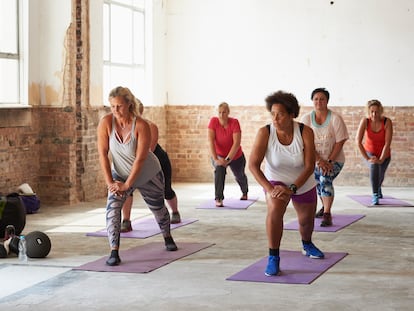Get up, stand up: How a job that ties us to a chair affects our body
The sedentary office workday affects muscular health with issues such as so-called ‘dead butt syndrome,’ which occurs when the glutes forget how to activate after prolonged inactivity

According to the UK-based human resources analysis group HRreview, a typical office worker spends 1,300 hours a year at their desk. This sedentary lifestyle, intensified in certain work contexts, has direct consequences on our body and negatively affects muscle health, especially when we do not adopt an appropriate posture during the long hours we are sitting. “Prolonged inactivity leads to a decrease in muscle mass, the direct consequence at the muscular level of spending many hours sitting, which can be transferred in the long term to less strength and endurance,” explains Ana Carabel, from the Quiron physiotherapy centre. And the expert points out: “A muscular imbalance also occurs because, for example, the dorsal or lumbar area is constantly under tension and in contrast other muscles that are very important, such as the glutes or hamstrings, tend to weaken.”
Specifically, in reference to how a sedentary lifestyle affects the gluteal area, the The New York Times delved a few weeks ago into the concept of so-called “dead butt syndrome,” or gluteal amnesia, one of the effects derived from spending a good part of our daily life sitting down. What exactly does it consist of? When sitting, the buttocks are in a stretched position and if this is maintained for a prolonged period of time, the muscle can “forget” its subsequent activation (which can be achieved, for example, by doing a gluteal bridge or quadruped extensions), hence the name gluteal amnesia or “dead butt.” And no, although it may seem so, it has nothing to do with the classic tingling that numbs the muscles when, usually due to a bad posture, the nerves are compressed. In this case the symptoms are not so immediate. At this point it is worth remembering that the gluteal region is divided into three parts: gluteus maximus, gluteus medius, and gluteus minimus, all with shared and specific functions as important as helping us to stand upright. The classic office worker’s job — tied to the chair from nine to five, in front of a screen and with little movement — weakens the gluteus muscles, but this peculiar amnesia has a particular impact on the gluteus medius, which is responsible for moving and rotating the femur or abducting the hip joint.
This “memory loss” does not only affect the buttocks, it can also trigger pain in other parts of the body. Imagine muscle tissue as a machine made up of dozens of gears. If any of them malfunctions, a chain failure can occur. Back pain, hip pain, or even knee pain could be among the collateral damage suffered by the muscles that end up assuming functions that should be performed by those amnesiac glutes. Luckily, there is a solution and it involves staying active and counteracting those static hours of the workday. For Carabel, strength training is very effective in alleviating general muscle pain caused by long hours in the office, regardless of “physical condition or age,” but always adapted to the needs of each person. “Strength is not just lifting weights, you can do strength exercises with your own body, with an elastic resistance band, or getting up from a chair; that is strength training,” says the expert. In the specific case of the glutes, the ideal method is to activate the area and strengthen it with specific routines in the form of reps. From the glute kick, to the famous hip thrust (for those unfamiliar with the sports jargon, it consists of pushing the hip with a weight) or the lateral plank with leg split.
The importance of posture and a good chair
Adopting a correct posture is key to avoiding or minimising muscle problems, but without a suitable chair, little can be done. The ideal office chair, explains Lina Jiménez, communications and events technician at office furniture manufacturer Actiu, “must be ergonomic, adjustable in height and backrest, offer good lumbar support, have armrests and adapt to the body’s morphology and movements.
“These aspects,” continues the expert, “ensure an adequate posture and reduce the risk of musculoskeletal ailments such as lumbago and contractures.” We must not forget that during the working day employees have the right to rest, a period of time that according to article 34 of the Workers’ Statute in Spain is 15 minutes for every six hours worked. Experts recommend reserving this time to stretch the legs and get as much movement as possible. And along with this prolonged rest, “the ideal is to take active breaks every 30-60 minutes to activate the muscles and improve circulation, encouraging mobility, as promoted by Actiu and its dynamic ergonomics approach,” says Jiménez.
Physiotherapist Carabel agrees, stressing the importance of staying active: “Every hour or so you have to get up from your chair, move around the work area, try to make work calls standing up, or get up to avoid muscle strain.” Spending the work day glued to the computer, eating in front of the screen and hardly getting up will not boost productivity — quite the opposite. In the long term it will impact physical and emotional health, so before your body cries out for help in the form of ailments such as gluteal amnesia, it is better to remember the problems that come with tying yourself to the office chair.
Sign up for our weekly newsletter to get more English-language news coverage from EL PAÍS USA Edition
Tu suscripción se está usando en otro dispositivo
¿Quieres añadir otro usuario a tu suscripción?
Si continúas leyendo en este dispositivo, no se podrá leer en el otro.
FlechaTu suscripción se está usando en otro dispositivo y solo puedes acceder a EL PAÍS desde un dispositivo a la vez.
Si quieres compartir tu cuenta, cambia tu suscripción a la modalidad Premium, así podrás añadir otro usuario. Cada uno accederá con su propia cuenta de email, lo que os permitirá personalizar vuestra experiencia en EL PAÍS.
¿Tienes una suscripción de empresa? Accede aquí para contratar más cuentas.
En el caso de no saber quién está usando tu cuenta, te recomendamos cambiar tu contraseña aquí.
Si decides continuar compartiendo tu cuenta, este mensaje se mostrará en tu dispositivo y en el de la otra persona que está usando tu cuenta de forma indefinida, afectando a tu experiencia de lectura. Puedes consultar aquí los términos y condiciones de la suscripción digital.
More information
Archived In
Últimas noticias
A survivor’s account of the Interoceanic Train accident: ‘We were scared because of the speed on the curve’
The Interoceanic Train, the Mexican alternative to the Panama Canal
What is known about the Interoceanic Train derailment in Oaxaca
Trump turns a Minnesota fraud allegation into ammunition for his MAGA army against Democrats
Most viewed
- Oona Chaplin: ‘I told James Cameron that I was living in a treehouse and starting a permaculture project with a friend’
- Reinhard Genzel, Nobel laureate in physics: ‘One-minute videos will never give you the truth’
- Why the price of coffee has skyrocketed: from Brazilian plantations to specialty coffee houses
- Pablo Escobar’s hippos: A serious environmental problem, 40 years on
- Chevy Chase, the beloved comedian who was a monster off camera: ‘Not everyone hated him, just the people who’ve worked with him’











































